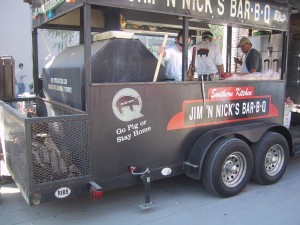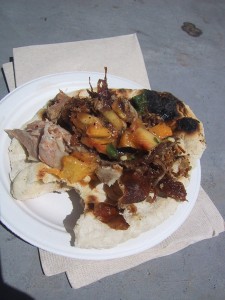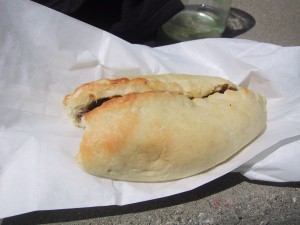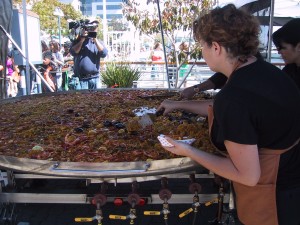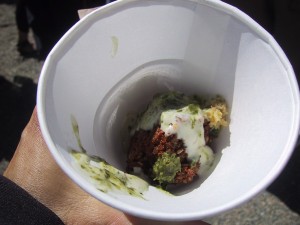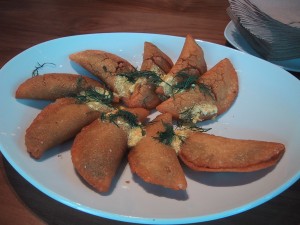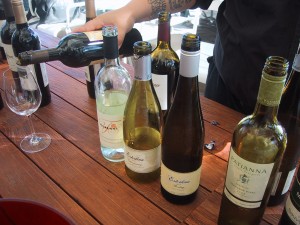Doing something out of the ordinary seemed like the thing to do this past Saturday. Rather than spend the day running the usual round of errands, I packed up the car with a water bottle and a few snacks, and drove to Oakland to attend the second annual Eat Real Festival in Jack London Square. Eat Real is the brainchild of my friend and colleague Anya Fernald. After cutting her teeth on the inaugural Slow Food Nation, she decided to take good food to the streets, literally. Eat Real brings a multitude of food trucks, artisan producers, restaurants, and food stands to the Oakland waterfront. The festival itself is free. It pays its way through sponsorships and sale of beverage tickets. The food vendors are paid cash by the patrons, and nothing cost more than $6! How can I lose? I parked the car in the underground garage, stuffed my pockets with about $30 in cash, and ventured into the already busy street.
First stop was the event office, to trade in my VIP pass for a logo Mason jar and six drink tickets. I received an invitation to attend a tour and coffee “cupping” at the popular Blue Bottle Coffee Company, a block and a half up the hill from the festival itself. I had a few minutes to spare before the noon start time, so I wandered over to the “Wine Barn,” where my friends from Mendocino County were setting up. The prior day’s tastings had been well received, and the group was gearing up for the second day of the three day festival. With a promise to return later in the afternoon, I wandered off to the south end of the grounds in search of my favorite 4505 Chicharrones. I found the stand, immediately recognizable by the fluttering paper pig cutouts, strung across the front of the service counter. Three dollars would buy me a small bag of the delectable savory bits of fried pork skins, and I asked the girl for a bag. “Only one” she asked. “Two then” I replied, as no one could possibly eat just one. Munching on a handful of the sweet, spicy and salty puffs, I wandered up the street to Blue Bottle.
It turns out that “cupping” is exactly what it sounds like. Freshly roasted and ground coffee is carefully measured into a cup, and topped with steaming water, heated to a specific temperature. The idea is to replicate the exact same brewing conditions for each batch of beans to be evaluated. The first of three cups remains dry in order to allow you to inhale the aroma of the freshly ground coffee. The second cup steeps for four minutes, and then a spoon is used to break the foam crust on the coffee and inhale the first whiffs of the aroma of the freshly brewed coffee. After that, the foam is removed from the second and third cups, and the coffee is actually tasted with a clean spoon. The coffee is tasted just like wine or olive oil, drawing air in across your palate with your mouth open in order to experience the flavor and the aroma combined. Who knew that coffee could be as interesting as wine? After the “cupping,” we were served another batch of the same coffee, brewed in a Chemex, for drinking this time.
Returning to the festival grounds, munching on the second bag of chicharrones, I realized I was finally hungry enough to brave the lines for some real food. The smells were amazing. Behind Chop Barn’s stall, a row of Caja China grills were set up with whole pigs roasting over the coals and flatbreads toasting on the grill above. Unable to resist, I joined the line and handed over another $6. In exchange, I received a warm flatbread, topped with both moist and crispy bits of pulled pork. On the adjacent table, I had a choice of freshly grilled peach salsa, watermelon rind pickle, tomatillo salsa or chili oil with orange peels. After dressing the pork with peaches and the orange chili oil, I took my first bite. Belatedly remembering the camera, I found a concrete wall to sit on, and snapped a quick picture before polishing off the entire thing.
After surveying the long lines at the more popular taco trucks (traditional Mexican, Salvadorian, Philipino and Korean), I chose a piroshky stand. Three beautiful young Russian women were heating and serving a choice of chicken, beef and onion, or vegetarian spinach and cheese. Being the unabashed carnivore that I am, I opted for the traditional beef and onion. The crust was golden and flaky, and the filling almost hot enough to burn my tongue. Once again, the photograph was an afterthought, as I captured the image with a bite taken out of it. Since I was close to the Wine Barn, I swung by and picked up a glass of Navarro gewürztraminer. It was perfectly chilled, and the fruity spiciness was a perfect counterpoint to the rich piroshky.
A friend was finished with her shift at the Meet the Winemaker booth, so we struck out to further peruse the food offerings. Her goal was the Beer Shed, at the far south end of the festival grounds. On the way, we passed by what had to be the largest paella pan I have seen to date. The vendor had several staff members tending the over 8’ diameter pan, with its specially-constructed gas burners that allowed the paella to cook slowly and evenly. The line wound around the booth and up the aisle, so we deferred, pushing on through the crowd.
Our next stop was the falafel truck, where we purchased a “sampler” cone of two falafels, hot from the deep fryer served with tahini and a fresh herb puree. Biting through the crisp crust, I encountered a creamy yet toothsome center, owing to the fact they were made with freshly cooked favas and chickpeas, rather than the ubiquitous ground mix. They were vegetal and savory, and went perfectly with the microbrew beers procured when we finally reached the Beer Shed.
We couldn’t leave that end of the festival until we sampled the marvelous pork and beans served by Rancho Gordo New World Beans and Boccalone. The huge and tender cannellini beans were stewed with nduja, a soft Calabrian pork sausage and favorite of local chefs who frequent Boccalone’s stand in San Francisco’s Ferry Plaza Market. The creaminess of the beans offset the spicy bite of the sausage, which literally melted into the sauce. On the way back, I also sampled a sweet potato-Thai tea popsicle from Fat Face, and an incredible spoonful of pistachio sorbet. Even though I was trying to avoid the multitude of sweets, I succumbed to temptation for these two, which were worth the splurge.
Returning to the main square, we entered Bocanova, the restaurant hosting the VIP reception and cocktail hour. More delectable goodies awaited us, along with a great selection of our favorite Mendocino County wines. I was able to sample a variety of empanadas, meatball sliders, olive-oil confit pork on a crostini, and incredible deep-fried Japanese mini peppers. They literally burst in your mouth, with a balance of heat from the pepper and heat from the frying, with a slightly salty finish. I couldn’t resist popping several more into my mouth, even when warned that eventually, I would encounter a spicy one. When I finally rolled down the stairs of the parking garage to the car, I was surprised that I could even fasten the seatbelt. I was stuffed, and yet, had not even begun to taste everything available at the festival. Even if I had attended all three days, I doubt I could have tried all the dishes. Some of what I missed, I circled for next year; artisan dim sum, Philippine Sisig tacos, lobster rolls, and a miscellany of dessert items.
In retrospect, examining whether this flavorful mélange of food offerings served to encourage patrons to “eat real” is the point around which the entire concept revolves. Truthfully, many of the food cultures represented support a tradition of artisan or hand-made foods. In addition, these traditions are not always well known to the average American. By broadening the patrons’ horizons a bit, new possibilities are explored. In reality, it takes a truly adventurous home cook to attempt to replicate some of these dishes. However, food trucks and stalls bring variety and breadth to the urban eating experience, and offer real alternatives to American fast food. Here in Mendocino County, where even Mexican taco trucks are not widespread, it presents somewhat of an insurmountable challenge. My departure was somewhat bittersweet, knowing that if I wanted to experience these dishes again, I would either need to duplicate the recipes at home, or return on a regular basis to the San Francisco Bay area to stalk the food trucks. I was particularly impressed by the demographic diversity of the attendees, and the presence of so many young families. This next generation is the foundation of fundamental change in our food system, and will become the evangelists that carry the message beyond the urban landscape.
Post by Julia Conway on September 3rd, 2010

